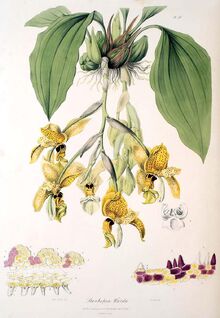| Stanhopea | ||||||||||||||||
|---|---|---|---|---|---|---|---|---|---|---|---|---|---|---|---|---|
| ||||||||||||||||
Stanhopea (J. Frost ex Hook. 1829) is a genus of the orchid family (Orchidaceae) from Central and South America. The abbreviation used in horticultural trade is Stan.
Distribution[]
Plants are found from Brazil to Mexico in high elevation wet cloud forest on trees or on slopes.
Description[]
Their ovate pseudobulbs carry from the top one long, plicate, elliptic leaf. It is noted for its complex and usually fragrant flowers that are generally spectacular and short-lived. Their pendant inflorescences are noted for flowering out of the bottom of the containers in which they grow, lending themselves to culture in baskets that have enough open space for the infloresence push through. They are sometimes called aptly upside-down orchids.
Plants are pollinated by bees which follow their fragrance.
With most Stanhopea flowers lasting three days or less, the blooms must attract pollinators very quickly. These chemical attractants are generated in the hypochile, attracting the male euglossine bees to the flower. When the bee touches down on the flower, a great effort is made to collect chemical scent - he eventually slides on the waxy surface of the hypochile, gliding down on the slippery lip to exit the flower. The long column is touched in the process, resulting in the bee taking up pollinia at the very tip of the column. When a the bee slides down another flower, the pollinia are deposited on the sticky surface of the stigma.
Flowers were first drawn in Mexico in 1628. The first descriptive drawing was by Fernando Hernandez of Stanhopea hernandezii
Primitive Stanhopeas
Most Stanhopea flowers flash prominent, elegant horns on the epichile. The exception are the species; Stan. annulata, Stan. avicula, S. cirrhata, Stan. ecornuta and Stan. pulla. A second group have short or truncated horns, they include the species; Stan. candida, Stan. grandiflora, Stan. reichenbachiana, Stan. tricornis and the natural hybrid Stan. x herrenhusana. The structure of the labellum of this group is in general, not as complex as other members of the genus.
The majority of species are robust plants that grow readily in cultivation. For relatives of Stanhopea see Stanhopeinae and the closely sister subtribe Coeliopsidinae.
Culture[]
Stanhopeas should be grown in bright light and intermediate temperatures from 52° to 60°F at night, with day temperatures 68° to 75° F in the winter. The light should not be direct sunlight because leaves will be burnt. Cool night temperatures usually promote flowering. Water frequently and keep mix moist. Dry roots lead to leaf-tip dieback, or a browning of the leaf tip. Reduce watering frequency in the winter but do not let mix dry. Keep humidity from 40% to 75% and high when temperatures are hot. Keep good air circulation. Plant is best replotted after blooming or in the winter. Pot in a loose well, drain mix, and airy mix such as tree fern fibers, medium fir bark, or osmunda fibers.
Naming[]
The genus is named for the 4th Earl of Stanhope (Philip Henry Stanhope) (1781-1855), president of the Medico-Botanical Society of London (1829-1837).
Synonyms[]
- Ceratochilus Lindley 1825
- Stanhopeastrum Rchb. f. 1852
- Tadeastrum Szlach., 2007
Species[]
|
Natural Hybrids[]
- Stanhopea × fowlieana (Stanhopea costaricensis × Stanhopea ecornuta) (Costa Rica)
- Stanhopea × herrenhusana (Stanhopea reichenbachiana × Stanhopea tricornis) (Colombia)
- Stanhopea × horichiana (Stanhopea ecornuta × Stanhopea wardii) (Costa Rica)
- Stanhopea × lewisae (Stanhopea ecornuta × Stanhopea inodora) (Guatemala)
- Stanhopea × thienii (Stanhopea annulata × Stanhopea impressa) (Ecuador)
References[]
| This page uses Creative Commons Licensed content from Wikipedia (view authors). | 
|
- Rudolf Jenny (Dec 1993) "The Genus Stanhopea," in: Orchids 62(12):1270-1277
- Rudolf Jenny (Dec. 2003) "The Genus Stanhopea. Part 1: S. anfracta to S. napoensis," in: Caesiana no. 21, Supplement. 200 color photos, 160 p.
- Jenny, R. (2004) "The genus Stanhopea : 2nd part, S. nigripes to S. xytriophora" Caesiana no. 22: 146-291.
- Gerlach, G. (2004). Die Subtribus Stanhopeinae. 6. Stanhopea. J. Orchideenfreund 11 (1): 53-76. (in German)
- Stanhopea Orchids
